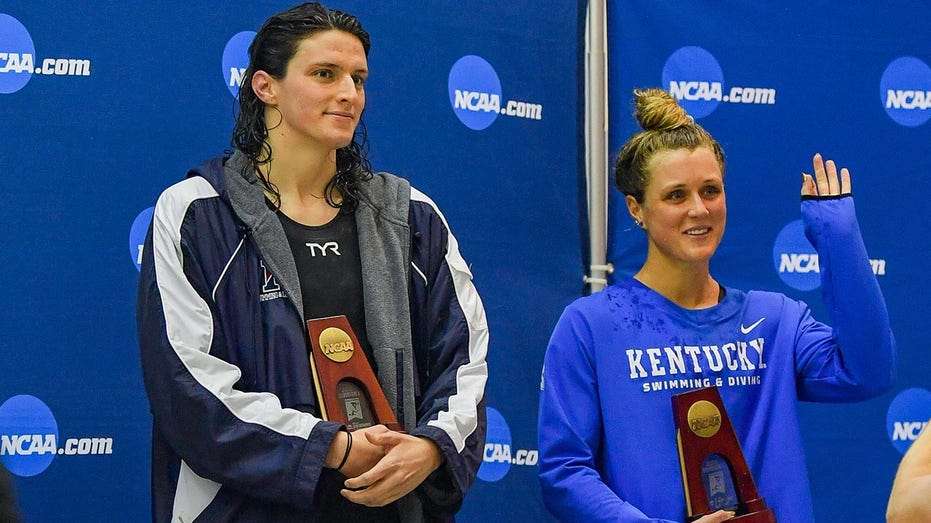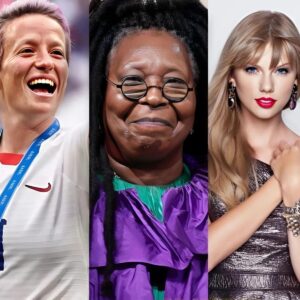Lia Thomas has been swimming since she was five years old. As a high schooler, she was one of the top swimmers in Texas, an All-American. She followed her older brother onto the men’s team at the University of Pennsylvania, and established herself as a strong competitor in distance races; in her sophomore season, at the Ivy League championships, she finished second in three events. Out of the pool, though, she was struggling. Her body, with its solid pectorals and compact, muscled hips, characteristic traits of a male athlete, didn’t align with her sense of who she was, she later told the podcast SwimSwam, in one of the two interviews she has given this season. She read the personal stories of trans women online, and was paired with a trans mentor through a group at Penn. She saw her own feelings reflected in their stories, she recently told Sports Illustrated. In the summer of 2018, after her freshman season, she realized that she was a woman, not a man.
It took her a while to come out to her teammates and coaches. She didn’t want to jeopardize her swimming career. And she was swimming well: setting personal bests, breaking pool records. Still, the suffering became too much; knowing that she was a woman and competing as a man “caused me a lot of distress,” she has said. In May, 2019, she decided not to put off hormone-replacement therapy any longer. Almost immediately, she told Sports Illustrated, she felt better. She was determined to hold on to that part of herself that was a competitive swimmer. She came out to her coaches. They were immediately supportive, she said, and they stood by her when she decided to join the women’s team. So were her friends.

The N.C.A.A. allowed a path for people like her to join the women’s team, but it was not quick or easy. In general, élite male athletes have considerable physical advantages over élite female athletes. People who have gone through testosterone-driven puberty have, on average, more cardiovascular capacity, greater muscle mass, higher tendon mechanical strength, and denser bones. They tend to be stronger and taller, with longer wingspans. In many sports involving timed races, men are roughly ten to twelve per cent faster than women. The Olympic track champion Allyson Felix’s lifetime best in the four hundred metres is 49.26; in one year, 2017, that time was bettered by men and boys more than fifteen thousand times. In sports involving jumping and pure strength, the gap is even greater. As trans women have fought for inclusion in women’s sports, various governing bodies have implemented rules for mitigating any physical advantages that they might have. But just what those advantages are and how to counteract them—and whether that is necessary or even possible—has been fiercely debated.
The International Olympic Committee began allowing trans athletes to compete in 2004. At first, the I.O.C. required athletes to legally change their gender and undergo genital surgery, as if a mislabelled passport and the presence of a penis gave them a leg up on the competition. The N.C.A.A., six years later, took a different approach. After consulting with students, medical experts, and people from the L.G.B.T.Q. community, the association announced that trans women would be able to compete on collegiate women’s teams after one year of testosterone suppression. Other governing bodies, including the I.O.C., went on to adopt similar rules.
The focus on testosterone seemed, to many, straightforward: on average, men have testosterone levels around fifteen times that of women, and the competitive advantages of taking testosterone—at least exogenous testosterone, a steroid—were well established. But the research concerning endogenous testosterone, the kind that the body makes naturally, was less settled. There is a gap between the range of testosterone levels in men and the range in women—one researcher described it to me as a “chasm”—but there is enough variability among élite athletes to create some small degree of possible overlap between sexes, and researchers have not been able to establish a definitive causal relationship between individual testosterone levels and athletic performance. Bodies produce differing levels of the hormone, and have differing abilities to make use of it; comparing the testosterone levels of eight cisgender runners or swimmers of the same sex before a race does not tell you who will win it.
At the same time, hormone-replacement therapy may not counteract all the competitive advantages a body might gain during testosterone-driven puberty. It may not fully reduce the difference in lean body mass or in grip strength, for instance, or change the width of a pelvis. And so, while some people maintain that there is not enough evidence to justify rules requiring testosterone suppression, others insist that such rules don’t do enough.
As Thomas underwent hormone-replacement therapy, and went through something like female puberty, she noticed some of her muscles softening. Fat was redistributed around her body, and she felt herself losing aerobic capacity. Her times in the pool started rising. She continued to swim with the men’s team, sporadically, wearing a women’s suit. Then the pandemic started, and the season was cut short; the next season was cancelled altogether. Thomas kept up the hormone therapy, and preserved her final year of eligibility. By the time the current season started, she had been suppressing testosterone for more than two years. She felt happy, she said, to compete, finally, as her “authentic self.”
Few people paid attention when, in a meet against Princeton and Cornell, in November, she put up the season’s best times in the two-hundred-yard and five-hundred-yard freestyle races, and set Penn records. But, in early December, at the Zippy Invitational, in Akron, Ohio, Thomas dropped another second off her time in the five-hundred-yard freestyle, and nearly a second and a half off her time in the two-hundred-yard race. She won the sixteen-hundred-and-fifty-yard freestyle by thirty-eight seconds. On the same day, a group of parents of Penn swimmers anonymously sent a letter to the N.C.A.A. arguing that Thomas should not be allowed to compete in women’s competitions. “At stake here is the integrity of women’s sports,” the parents’ letter, which was also sent to Penn and the Ivy League, declared. “The precedent being set—one in which women do not have a protected and equitable space to compete—is a direct threat to female athletes in every sport. What are the boundaries?”
The letter was leaked to the Daily Mail, and conservative outlets gleefully reported on rifts between Thomas and her teammates. Some published photos of Thomas from before her transition and referred to her using the name she had gone by then. Video of Thomas’s performance at the Zippy Invitational went viral. The father of one of Thomas’s teammates suggested to Fox News that trans athletes stood between his daughter and her Olympic dreams. “Lia is going to go to the N.C.A.A.’s, and she’s going to take down Katie Ledecky’s record, she’s going to take down Missy Franklin’s record, and it’s not because she is an exceptional woman,” he said.
In fact, Thomas’s top time in the five-hundred-yard freestyle is a full ten seconds slower than Ledecky’s, and Franklin’s record is also well ahead of Thomas’s best. It’s possible that Thomas will best them at the N.C.A.A. Championships, which began on Wednesday, but to hear some people, the broken records are a foregone conclusion. Some even speak about them in the past tense: Diana Nyad, the legendary open-water swimmer, wrote an op-ed for the Washington Post criticizing the rules that allowed Thomas’s participation, in which she claimed that, in two events, Thomas “swam faster than any female college swimmer in history.” (Thomas swam faster than any female college swimmer this year, not in history. Nyad’s piece was subsequently corrected.)

Thomas stayed quiet, declining most interview requests, including mine, and fixing her gaze on the black line at the bottom of the pool. There was even an unobtrusive quality to her stroke: her kick is quiet and efficient, a calm set off by the churning and splashing of competitors in her wake. But the tension on the Penn team grew more public. After Thomas lost a race to Iszac Henig, a transgender man who has not medically transitioned and swims for Yale’s women’s team, one of Thomas’s teammates anonymously accused them of colluding on the result. There were reports of swimmers “upset and crying” on the pool deck. A U.S.A. Swimming official resigned in protest of Thomas’s being allowed to compete in women’s meets.
It was impossible to ignore the political context in which all this was happening: hundreds of bills have been introduced to restrict transgender people’s access not only to sports but to health care. There was something absurd in the spectacle of conservative politicians who have never shown any interest in supporting women’s sports, which are chronically underfunded and underexposed, moralizing about the sanctity of collegiate women’s swimming. But the opposition, or at least the uneasiness, concerning Thomas’s participation did not fall simply along partisan lines. Within the world of women’s sports, and even among some trans people who are a part of that world, there are those who are struggling to decide what is fair, and what is just. If Thomas had not physically transitioned, she would almost certainly have broken all those records that people seemed to think she was already breaking. (Her best five-hundred-yard time before her transition was about seven seconds faster than Ledecky’s record.) Would that be a problem? Is it ethical to require medical interventions of healthy people who wish to compete in women’s sports? If one believes that we should distinguish between élite and youth sports, where does the line fall? Who is harmed by restrictions, or by the lack of them? What basic rights apply to athletics?
Female athletes have bodies of different sizes, colors, shapes, and sexualities. Those bodies, especially those that differ from a feminine—and, often, white—ideal, have, for a long time, been castigated as too muscular, too masculine, too threatening. Women’s sports have thrived by challenging the limits that circumscribe what women can supposedly do, and who they supposedly are. At the same time, the division of sports into men’s and women’s categories serves a purpose—it allows female athletes to be considered on their own terms; Allyson Felix’s speed is not less remarkable because some number of teen-age boys are faster than she is. The argument about Lia Thomas, a college student from Texas in her early twenties, is also an argument about whether there are, finally, defining lines, and who gets to set them.
Joanna Harper is a nationally ranked master’s runner. For a long time, she competed alongside men. But, in 2004, she decided to begin hormone-replacement therapy and compete in the category of her gender identity, as a woman. She began taking a drug to suppress her testosterone, plus a small dose of estrogen. She was startled by how quickly and comprehensively her body changed. She had expected to add a minute or two to her ten-thousand-metre time, but, in less than a year, she was running a full five minutes slower than before. Within two years, she was doing roughly as well against women as she had done before her transition, running against men.
She looked for scientific research into what she was experiencing—high-level transgender athletes were uncommon, but not unheard of; the tennis player Renée Richards competed on the W.T.A. tour as far back as the nineteen-seventies—but she couldn’t find any, so she did it herself. She looked for the race times of other competitive transgender female runners, and eventually was able to compare the times of eight women before and after transition. This was an admittedly small sample size: Harper was one of the eight subjects, and the study only considered long-distance running; it didn’t necessarily bear on performance in others sports. Still, the results were suggestive. Harper found that all eight women had an “age grade”—a measurement of runners that accounts for age and sex—largely similar to what it had been prior to their transitions. Harper’s study suggested that women who had undergone hormone-replacement therapy appeared to have no significant advantage over cisgender long-distance runners. It was published in the Journal of Sporting Cultures and Identities, in 2015, becoming the first peer-reviewed paper on the effects of testosterone suppression for trans female athletes.
That same year, with counsel from Harper and many others, the I.O.C. changed its rules for trans athletes. Genital surgery was no longer mandated. Trans women who completed one year of hormone therapy could compete in the category of their gender identity, provided their testosterone levels remained below a certain threshold, which was set above the usual range for cisgender women but below the average for cisgender men. That standard inevitably prompted criticism. The sociologists Katrina Karkazis and Rebecca M. Jordan-Young, who co-wrote “Testosterone: An Unauthorized Biography,” have disputed the idea that “testosterone is the miracle molecule of athleticism,” noting that different sports require different skills, and that “athleticism” is a catch-all term for a variety of abilities and characteristics. Others pointed out that sports never entail an even playing field, given the different resources, genetic and otherwise, that athletes have; naturally occurring testosterone can be considered part of the biodiversity of athletic talent.
The most stinging criticism invoked the I.O.C.’s history of mishandling of sex-related disputes, including, famously, the case of Caster Semenya, a South African runner whose body naturally produced unusually high levels of testosterone. Semenya ultimately refused to take medication that would reduce her hormone levels, describing her decision as a matter of human rights. The situation for trans athletes was different: many trans people opt to undergo gender-affirming hormone-replacement therapy quite apart from any athletic considerations. Still, a number of observers remained troubled by the idea of a traditionally white, patriarchal institution defining, and policing, the supposed boundaries of womanhood.
Harper maintains that, in many sports, at the élite level, a degree of medical intervention is necessary for fairness. She was disappointed when, last November, the I.O.C. revised its policies again, this time abandoning a set of standard rules across sports in favor of a “framework,” built around ten principles, starting with “inclusion,” followed by “prevention of harm” and “non-discrimination.” The framework directs the governing body of each Olympic sport to craft its rules according to these principles. There should be “no presumption of advantage” from transgender status, the framework instructs, and any restrictions on transgender participation must be based on “robust and peer reviewed research.”
There was a logic to the I.O.C.’s shift: Olympic sports vary enormously; what makes sense for archery may not make sense for the long jump. And some were heartened, too, by the I.O.C.’s decision to emphasize human rights. “Valuing inclusion and non-discrimination, first and foremost—I think that’s really what’s important,” Schuyler Bailar, who became the first openly trans swimmer to compete in N.C.A.A.’s Division 1, told me. “We have so many trans people and intersex people that are just constantly discriminated against.” As a star swimmer in high school, Bailar had been recruited by Harvard’s women’s team, but had delayed enrollment to deal with an eating disorder—one that he came to realize was related to gender dysphoria. During the year between high school and college, he began a physical transition, undergoing a double mastectomy, and when he arrived at Harvard, in 2015, he joined the men’s team, with the support of his coaches. Athlete Ally, an L.G.B.T.Q. advocacy group that Bailar has worked with, was among the groups that offered guidance on the new I.O.C. policy.
Others, though, pushed back against the I.O.C.’s change of tone. Yannis Pitsiladis, a sports scientist who has served as the chair of the scientific commission of the International Sports Medicine Federation and on the I.O.C.’s own medical and scientific commission, told me that he welcomed the move away from a single approach for all sports, but balked at the decision to issue recommendations instead of specific rules—and at the suggestion that there should be no presumption of advantage for athletes who have undergone testosterone-driven puberty. He spearheaded a statement, signed by a number of prominent sports scientists, criticizing the I.O.C., and insisting that it was “well established in the literature” that the effects of testosterone are “responsible for much of the sex differences in sports performance between cisgender men and cisgender women.”
Harper, for her part, signed a statement issued by the International Federation of Sports Medicine, which asserted that, while testosterone suppression is imperfect, it remains the best biomarker for insuring fair competition in élite sports. She believes that no medical interventions should be required below the state championship or N.C.A.A. level, and she supports Thomas’s participation in collegiate swimming, she told me, given that Thomas has undergone two years of testosterone suppression. “I’m not saying testosterone is the only thing that matters,” Harper said. “But if you’re differentiating between male athletes and female athletes, you should use some factor that’s sexually dimorphic and is important for athletic performance. Testosterone is the best one that fits both of those.”
In January, the N.C.A.A. announced a new “sport-by-sport approach to transgender participation” in athletics, dropping the blanket requirement that trans women undergo a year of testosterone suppression, and leaving specific policies up to the national governing bodies of individual sports. The N.C.A.A. described this approach as in alignment with the changes made, the previous fall, by the I.O.C. But the N.C.A.A. did not produce a new formal framework of principles to guide each national body. Athlete Ally released a statement expressing alarm at the new policy, which the trans activist and athlete Chris Mosier described as “quickly assembled under pressure from people who don’t want to see a great athlete who is transgender succeed.” It was “clear,” Athlete Ally added, that trans athletes would be “subjected to invasive, painful and unnecessary medical procedures” and “burdened with the obligation of proving they have no inherent advantage instead of being viewed as human beings who have no desire to compete unfairly, only to participate in the sport they dedicate their lives to.”
A few days later, as Sports Illustrated subsequently reported, a former swimming champion and a Title IX lawyer named Nancy Hogshead-Makar organized a virtual meeting attended by more than two hundred and fifty people, including former Olympians, current collegiate swimmers and coaches, parents of Penn swimmers, and members of U.S.A. Swimming’s board of directors. The aim was to discuss legislation that would prohibit trans women from competing head-to-head with cisgender women in a number of collegiate sports, including swimming—perhaps even before Thomas had a chance to compete in the N.C.A.A. championships, in March. For a long time, Hogshead-Makar’s most notable causes had been equitable funding for women’s programs and the sexual abuse of women in sports. But three years ago, she had what she called an “aha” moment, when Congress was debating the Equality Act, which would ban both gender and sex discrimination—effectively, as she saw it, erasing the difference between the two concepts. She wanted a carve-out for competitive sports, insisting that Title IX was threatened from a legal perspective without it. Last year, she helped create the Women’s Sports Policy Working Group, the stated aim of which is to find a “middle way” with regard to the participation of trans women in women’s sports. The group’s Web site touts the support of both Joanna Harper and Renée Richards, but none of the group’s members are trans, and its most famous member, Martina Navratilova, has angered many trans athletes and advocates with comments she has made in the past. (Harper told me that she has disagreements with the group’s positions, including on Thomas’s participation. She added, “I have not, however, formally withdrawn my name as a ‘supporter’ of the group. I think that more can be accomplished with dialogue than with debate.”)
It doesn’t matter that Lia Thomas is just one swimmer, Hogshead-Makar told me. To a lawyer, precedent is everything. “I’m not an expert on the science, but I am an expert in civil-rights law,” she said. The law when it comes to sports, she went on, “is we allow sex segregation because of biology. We don’t allow sex segregation for any other reason.” I suggested that the biology of sex differences between athletes was murky, and that the legacy effects of testosterone-driven puberty were not totally established or understood. She countered by sending me white papers by sports scientists, a PowerPoint presentation by a developmental biologist, and a statement on the significant role of testosterone in athletic performance signed by forty-one doctors and scientists.
Hogshead-Makar has argued against laws that would ban transgender kids from all participation in sports, but her other positions, and the ways she talks about them—she insists on referring to “biological” genders, for instance—put her deeply at odds with those in favor of broader trans inclusion. (A state legislative director at the Human Rights Campaign has referred to the Women’s Sports Policy Working Group as a hate group.) Hogshead-Makar has suggested that, in some sports, trans women should occupy their own classification, apart from women, and proposed to me that Thomas be allowed to swim in a separately demarcated lane, next to the eight set aside for cisgender women, and have her own podium. She has argued that Thomas, far from being unjustly treated, is being opportunistic in her desire to win. Of course, one could also argue that there is an opportunism involved in seizing on Thomas’s case to advance a broader cause. “We’re somewhat lucky,” Hogshead-Makar told me at one point, “that Lia came along in an objective sport, where we have times, in a sport where race is not an issue. There are always charges of racism in track and field.”
Hogshead-Makar says that she is in favor of inclusion where the so-called legacy advantage of testosterone-driven puberty can be overcome—in marathons, perhaps, given that testosterone suppression can substantially reduce aerobic capacity and hemoglobin levels, or in sports like pistol shooting. “Lia’s times are the evidence that she has not mitigated,” Hogshead-Makar said, citing Thomas’s N.C.A.A. rankings when she competed against men versus her rankings against women. “If you go from a thousandth place to a thousandth place, that’s fair,” she said. “But she’s going from not being able to qualify for the N.C.A.A.s to being ranked first.” It should be noted that, when Thomas was competing against men, as a freshman, she once dropped thirteen seconds from her best thousand-yard freestyle time, setting Penn’s pool record, and that, more generally, athletes, particularly young athletes, can get better. But Hogshead-Makar’s argument reflects a broader truth about the situation: Lia Thomas would have attracted little attention if she always lost.
A few days after the N.C.A.A. announced its new approach, U.S.A. Swimming introduced new, more restrictive rules, calling for three years of testosterone suppression—mere months more than the length of time that Thomas has undergone. If the N.C.A.A. had immediately adopted the rules, Thomas would have been unable to compete in the championships. U.S.A. Swimming also instituted a three-person panel that will decide, on a case-by-case basis, whether adolescent physical development has given a trans woman an unfair edge over cisgender female athletes. It is not yet clear who will serve on that panel, and what criteria they might use. It does seem clear that the rule is designed to exclude trans people from the podium, if not from the pool. They will be allowed to swim, but, in most cases, not to win. As Christina Roberts, a trans doctor of adolescent medicine, who has studied the physiological effects of testosterone suppression, told me, often the only evidence considered legitimate that trans women have lost a competitive advantage is that “they’re no longer competitive.”
Laws against the participation of trans women in women’s sports at the collegiate level have already been passed in eleven states, and more are being considered. Some of them ban trans girls from elementary and youth soccer programs. Earlier this month, Iowa’s governor signed a law prohibiting trans girls and women from competing according to their gender identity; the law applies from kindergarten through college. Reading the arguments made on behalf of such laws, one might get the mistaken impression not only that Republican legislators place a great value on women’s sports but also that trans women are a conquering horde, swarming the leaderboards. In reality, trans women are grossly underrepresented at high levels of all sports, particularly in the winners’ circles. Based on simple demographics, one would expect there to be a few thousand trans athletes in the N.C.A.A. Instead, openly transgender collegiate athletes are disproportionately rare. If trans athletes have physical advantages, it appears these have been overwhelmed, so far, by social, legal, financial, and other disadvantages.
Transgender youth are more likely to be homeless and live in poverty. They are more likely to experience violence, bullying, rejection, depression, and suicidal ideation. In Texas, Thomas’s home state, the governor recently instructed licensed professionals who work with children to report parents of transgender children to state authorities, who would investigate gender-affirming care such as hormone-replacement therapy as child abuse. Sports are known to build self-esteem and leadership skills, and can be especially important for trans kids, the very people who are, in many places, being deprived of these opportunities. Some people worry that restrictions put in place by the I.O.C. and the N.C.A.A. will trickle down. “The Olympics, the élite levels, are making these rules, and clubs and P.E. football and sports like that are starting to follow suit,” Bernie Compton, a doctoral candidate in leadership studies and director of soccer operations at Bowling Green State University, who works as a research assistant for Athlete Ally, told me. “At youth levels, sport is about finding yourself, and enjoyment, and building healthy lifestyles and habits. By denying trans kids that opportunity, especially because they’re in a vulnerable state when they come out, they’re trying to erase trans kids from existence.”
There are élite organizations that are working in a concerted way to be inclusive—even, potentially, at the cost of competitive fairness. Last September, the National Women’s Hockey League dropped the word “women’s” from its name and rebranded as the Premier Hockey Federation. Trans women are allowed to participate without any hormone therapy, as long as they have lived in that gender identity for two years, and trans men are allowed to participate, even after taking testosterone, provided they apply for and receive a therapeutic use exemption. Élite athletes have signed amicus briefings opposing restrictions on transgender youth and sports, and made public stands in support of trans kids. The W.N.B.A. includes least one nonbinary and trans player, Layshia Clarendon, who, a year ago, underwent top surgery, and received broad support from inside the league. On the other hand, World Rugby last year formulated a policy explicitly barring trans women from its global competitions, on the grounds that, because trans women are, on average, larger than cisgender women, it would be dangerous for them to participate. Joanna Harper was at the meeting when it happened; she disagreed with the decision, and found the process dispiriting. “Frankly, I think they had their minds made up, before they called the meeting,” she told Out magazine. “It would have been nice to have seen a trans woman rugby player there, but I doubt it would have made any difference.”
Both Penn and the Ivy League signalled their support of Thomas. The Penn athletic department sent reporters a statement from other members of the swim team, which seemed to imply that only a small minority of her teammates opposed her participation. Hogshead-Makar then released a letter on behalf of sixteen of Thomas’s teammates—almost half the team—who urged Penn, anonymously, not to fight for Thomas’s ability to participate if the U.S.A. Swimming rules were adopted. “It’s disgusting and it’s cruel what’s being done to Lia,” a teammate of Thomas’s, Hadley DeBruyn, told Sports Illustrated, adding, “Sometimes, this doesn’t even feel like a team.”
In the end, the N.C.A.A. announced that it would not change its policies midseason. On February 10th, more than three hundred swimmers—including five of Thomas’s teammates—signed a letter in favor of Thomas competing in the championships, an effort organized by Bailar and Athlete Ally. Brooke Forde, a Stanford swimmer who swam at the Tokyo Olympics and will compete against Thomas in the five-hundred-yard freestyle at the N.C.A.A. championships, gave a statement to her father, the Sports Illustrated writer Pat Forde, which he read aloud on a sports podcast. “I believe that treating people with respect and dignity is more important than any trophy or record will ever be,” Forde said, “which is why I will not have a problem racing against Lia at N.C.A.A.s this year.”
Thomas was seeded first in three events at the Ivy League Championships, in February. After the five-hundred-yard freestyle, in which she set a pool record with a time of four minutes and 37.32 seconds—more than ten seconds behind Ledecky’s N.C.A.A. record, but one of the best swims of the season, and Thomas’s best since Akron—the other two Penn swimmers in the final applauded as she was awarded her medal, and posed for pictures. A day later, Thomas broke pool and Ivy League records in the two-hundred-yard freestyle; on the fourth day, she set a pool record in the one-hundred-yard freestyle. She won that final, too. (Iszac Henig finished second.) Thomas swam the first leg in the four-hundred-yard relay, which Penn won, setting a pool record. There were more tears from teammates on the pool deck, but these ones were from joy.
In the interview with Sports Illustrated, Thomas was understandably reticent and guarded. She declined to criticize the teammates who had spoken out against her, and she brought Bailar, who has become a close friend, so that he could make an independent recording. When I spoke to Bailar, he tried to give me some sense of what it might be like to be in Thomas’s position. “How do you show up at practice, not knowing which sixteen of your teammates did that?” he said, referring to the letter released by Hogshead-Makar on their behalf. “How do you—I mean, it makes me, like, it makes me so emotional, even just thinking about it.” He added, “There was a person on my team at the beginning of my experience who did not want me there. And when I found out, I was wrecked. I wanted to quit. I wanted to leave. I wasn’t sure if I wanted to stay in this world. One person—this happened with one person.”
At the end of last year, researchers at Duke, Marquette, and the Mayo Clinic studied Thomas’s swimming times before and after testosterone suppression. According to a preprint of a paper the researchers have authored, Thomas’s best times were around five per cent slower than her best times when she competed against men—a much smaller gap than the average difference between men and women. It may be that Thomas retains a significant metabolic and physiological advantage over cisgender women. It may be that she is an outlier. It may also be that she is swimming faster relative to her competitors than before in part because she is in a better place now—no longer battling gender dysphoria, able to swim, as she put it, as her authentic self, comfortable pulling on a swimsuit and feeling her body for what it is, slipping through the water.

Joanna Harper, like many people I spoke to, said that she wishes there were more robust, targeted scientific research on the performance of high-level trans athletes. Such research has been even harder than usual to produce during the coronavirus pandemic. She is now conducting a longitudinal study of trans athletes during their transitions, measuring as many physical changes as she can. But studies like that, by definition, take time. And Harper knows that some people are going to stoke panic and fear no matter what. “Every time there’s a successful trans woman athlete, the sky will fall tomorrow and it’s the end of women’s sports as we know it,” she said. “And it’s not,” she added, “it’s just not the end of women’s sports.” The same warnings were sounded when Renée Richards joined the women’s tennis tour, more than forty-five years ago, she reminded me.
In some respects, that era was just the beginning of women’s sports: it marked the launch of the Women’s Tennis Association, the passage of Title IX, and the first years that women were allowed official entry into marathons. (Early contestants were warned that their reproductive systems might be damaged by long-distance running.) These days, women’s sports, predicated on the idea of being separate but equal to men’s, are ascendent: interest is up, and opportunities are increasing. Still, the premises of the project are not simple. They demand not only a fight for investment and for respect but also continued, collaborative thought about what it means to be separate, and what it means to be equal.





